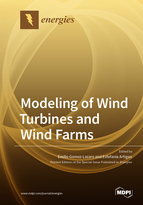Modeling of Wind Turbines and Wind Farms
A special issue of Energies (ISSN 1996-1073). This special issue belongs to the section "A3: Wind, Wave and Tidal Energy".
Deadline for manuscript submissions: closed (20 June 2019) | Viewed by 95445
Special Issue Editors
Interests: power electronics and power systems; renewable energy systems; modeling; dynamic performance of inverter-based generation in power systems; maintenance of renewable energy power installations; transmission and distribution studies
Special Issues, Collections and Topics in MDPI journals
Interests: operations and maintenance of wind turbines; condition monitoring of wind turbines; current signature analysis; doubly fed induction generators; reliability and availability of wind farms; onshore and offshore wind farms; failure rates and downtime of wind turbines
Special Issues, Collections and Topics in MDPI journals
Special Issue Information
Dear Colleagues,
Nowadays, Wind Power Plant (WPP) and Wind Turbine (WT) modeling are becoming of key importance due to the relevant wind-generation impact on power systems. Hence, wind integration into power systems must be carefully analyzed to forecast the effects on grid stability and reliability. Different agents, such as Transmission System Operators (TSOs) and Distribution System Operators (DSOs), are focused on transient analyses, aiming to deal with this issue. Wind turbine manufacturers, power system software developers, and technical consultants are also involved.
WPP and WT dynamic models are often divided into two types: Detailed and simplified. Detailed models are used for Electro-Magnetic Transient (EMT) simulations, providing both electrical and mechanical responses with high accuracy during short time intervals. Simplified models, also known as standard or generic models, are designed to give reliable responses, avoiding high computational resources. Simplified models are commonly used by TSOs and DSOs to carry out different transient stability studies, including loss of generation, switching of power lines or balanced faults, etc., Assessment and validation of such dynamic models is also a major issue due to the importance and difficulty of collecting real data.
This Special Issue aims to present solutions facing all these challenges, including the development, validation and application of WT and WPP models. Topics of interest include, but are not limited to:
- Detailed WT and WPP models
- Simplified WT and WPP models
- Model validation
- Transient stability studies
- Wind integration studies
- New control strategies
- Ancillary services
- Real time WT and WPP models
- IEC 61400-27 and WECC model assessment
- Grid code requirements
Dr. Estefania Artigao
Guest Editors
Manuscript Submission Information
Manuscripts should be submitted online at www.mdpi.com by registering and logging in to this website. Once you are registered, click here to go to the submission form. Manuscripts can be submitted until the deadline. All submissions that pass pre-check are peer-reviewed. Accepted papers will be published continuously in the journal (as soon as accepted) and will be listed together on the special issue website. Research articles, review articles as well as short communications are invited. For planned papers, a title and short abstract (about 100 words) can be sent to the Editorial Office for announcement on this website.
Submitted manuscripts should not have been published previously, nor be under consideration for publication elsewhere (except conference proceedings papers). All manuscripts are thoroughly refereed through a single-blind peer-review process. A guide for authors and other relevant information for submission of manuscripts is available on the Instructions for Authors page. Energies is an international peer-reviewed open access semimonthly journal published by MDPI.
Please visit the Instructions for Authors page before submitting a manuscript. The Article Processing Charge (APC) for publication in this open access journal is 2600 CHF (Swiss Francs). Submitted papers should be well formatted and use good English. Authors may use MDPI's English editing service prior to publication or during author revisions.
Keywords
- Wind power plant modeling
- Wind turbine modeling
- Wind integration
- Power system stability






